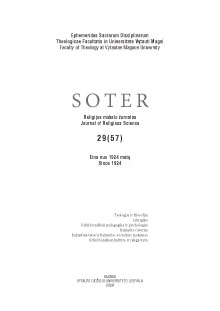Kauno seserų benediktinių vienuolyno pertvarka 1918–1926 m. (I)
THE REFORM IN THE CONVENT OF THE BENEDICTINE SISTERS OF KAUNAS FROM 1918 TO 1926 (I)
Author(s): Artūras Grickevičius, Aušra Vasiliauskaitė (Sr. Gabrielė OSB)Subject(s): Christian Theology and Religion
Published by: Vytauto Didžiojo Universitetas
Keywords: seserys benediktinės; vienuolynai; pertvarka; Benedictine sisters; convents; reform
Summary/Abstract: The Act of Independence of Lithuania signed in 1918 brought some confusion to the Convent of Benedictine Sisters in Kaunas, who had just recovered after the czarist persecution. The Sisters of Polish descent, forming the majority of the community had no concern to turn the convent into a hearth of Lithuanian culture. In 1919, due to the escalation of national relations, the convent was visited by the bishop Karevičius. His visit marked the initial stage of the convent’s political-material reform. The discontent Polish sisters complained to the Holy See and in 1920 the convent was already under irrevocable papal jurisdiction. Thereby the community of diocesan subordination became that of papal enclosure. According to the apostolic visitor A. Ratti, when the Polish nuns had opposed the establishment of a Lithuanian school at the convent, the conflict came to a sharper point. Later, according to the visitor A. Zecchini, the issue attracted the attention of some European countries, as well. Consequently, it was decided to separate the Polish nuns who settled in Kolainiai in 1924. Then the apostolic visitor archbishop Jurgis Matulaitis took care about the second spiritual reform. In Vatican the convent was entitled as a congregation, whereas in Lithuanian records it existed as a convent. Te change of the title does not, however, result in the change of jurisdiction. The Congregation of St Scholastica (USA), the Constitution of which was adopted by the Benedictine Sisters in Kaunas, is that of papal enclosure. The responses of the present day Benedictine Sisters in Kaunas to the questionnaire reveal that the reform of Jurgis Matulaitis resulted in the annulment of the papal enclosure and the reestablishment of the diocesan subordina¬tion. Thus, the convent became a congregation, Yet, it must be mentioned, that the above mentioned fact is not in accordance with the Benedictine tradition. The presented material has led to the following conclusions. The reform started because of the conflict between the Lithuanian and the Polish Benedictine Sisters. The conflict, which arose due to the complicated national and international relations, aggravated the situation of the monastic community and caused certain political and economical problems. The first stage of the reform at the convent of Benedictine Sisters in Kaunas began in 1918 and came to an end on February 29, 1924, when the Polish Sisters left to Kolainiai and a purely Lithuanian convent was established in Kaunas. This stage may be referred to as a political-material reform. The second stage of the reform started on February 29, 1924 and finished in 1926, when the monastic community underwent a re-formation according to the Rule of St Benedict and the charisma of its founder. This stage may be treated as a monastic-spiritual reform, The second part of the paper will focus on the impact of the reform one present day Benedictine Sisters in Kaunas. The author of the paper examines whether the reform mee
Journal: SOTER: religijos mokslo žurnalas
- Issue Year: 57/2009
- Issue No: 29
- Page Range: 69-84
- Page Count: 16
- Language: Lithuanian

